Geena Davis
Actor, archer, badass
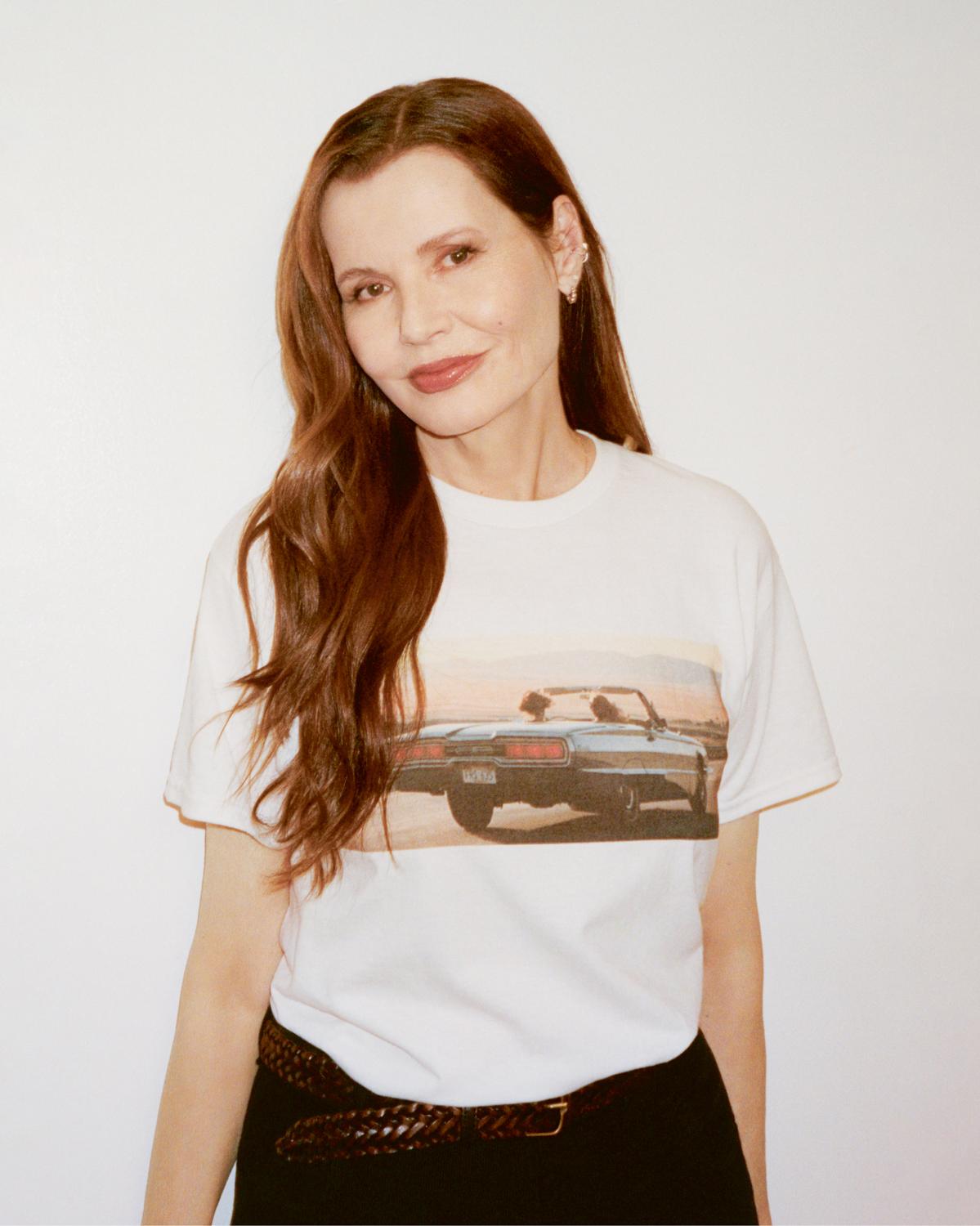
Portraits by Chris Rhodes
Styling by Gabrielle Marceca
Issue nº 29, Spring and Summer 2024
On Thelma & Louise, competitive archery and the irrefutable truth of data — GEENA DAVIS.
In May 1991, Thelma & Louise premiered, closing the Cannes Film Festival. A crime-drama buddy movie that controversially put two women in the lead roles, it would go on to earn both Geena Davis and Susan Sarandon nominations for best actress at the following year’s Oscars. “It was a small movie, but it exploded,” Geena says now, a touch of awe in that husky voice. “The reaction to that movie was so unlike anything I had experienced.”
Geena was already a bankable star by the time she appeared in Ridley Scott’s relatively low-budget road trip movie. She had an Oscar on her mantelpiece (for her supporting role in The Accidental Tourist), nine years of filmmaking behind her, and was one half, with Jeff Goldblum, of a Hollywood dream couple.
“People did recognise me once in a while, but suddenly, when they recognised me from Thelma & Louise, it was completely different. They had to talk to me about the film, how they felt very passionately about it, and explain what it meant to them.” Women in particular. “How it changed their relationship, how it changed their life. I was stunned. Sometimes they’d say, ‘My friend and I acted out your trip,’ and I’d be like, ‘Which part of the trip? Hopefully not a lot of it.’ ” Geena laughs uproariously and leans in across our table at Little Beach House in Malibu. She had glided into the restaurant a few moments before, her six-foot frame enveloped in a long chiffon shirt and rehearsal-room black, before selecting a spot in the shade. Her wide smile is still as dazzling as when she, as Thelma Dickinson, picked up a youthful Brad Pitt from a dusty roadside.
Incredible to think now, but one of the contemporary criticisms levelled at Thelma & Louise was that it glorified gun violence and suicide. Those conservative critiques were, of course, hypocritical cover for disapproval of its feminist theme: how put-upon women might seize their destinies from male control. Anyway, the box office takings made that irrelevant. Audiences loved it, and still do.
“What was shocking to Susan and me was that it struck a nerve in the way that it did, that it resonated,” Geena, 68, says, “because we were unsure that anybody would even see it. And it made me realise how few opportunities women have to feel like that about a movie – that when men watch a movie, they can identify with the lead character and live vicariously through them, but how rare that is for women. Which is why they had such an outsized reaction to Thelma & Louise.”
That film altered many viewers’ lives, but it also altered Geena Davis. She vowed to remember the response from female audiences and use it in her future career. Little did she foresee how far that idea would take her. “I didn’t set out to change media. What first happened was getting cast in Thelma & Louise.”
Geena began to choose roles with female eyes in mind. In 1992 came A League of Their Own, a comedy-drama in which she played Dottie Hinson, a star catcher in an all-female baseball team (the film, incidentally, is the most successful baseball movie of all time). The story of the fictional wartime Rockford Peaches wasn’t exactly political — it co-starred Madonna as a sex-mad pitcher – but Geena stuck to her plan. “We constantly had interviewers on set while filming. And invariably, whoever the journalist was, male or female, they would say: ‘So is this a feminist movie?’” Geena laughs. “As if they were saying something so naughty! I’d reply, ‘Yeah.’ And they’d say, ‘Wait a minute, are you saying that you’re a feminist?’” She pulls a comic-ally incredulous face.
According to Geena, its director, Penny Marshall, described A League of Their Own as “just about women”. “But I made a point. Because at that time, if you can believe it, nobody wanted to talk about being a feminist. It was the last thing you’d want to say.”
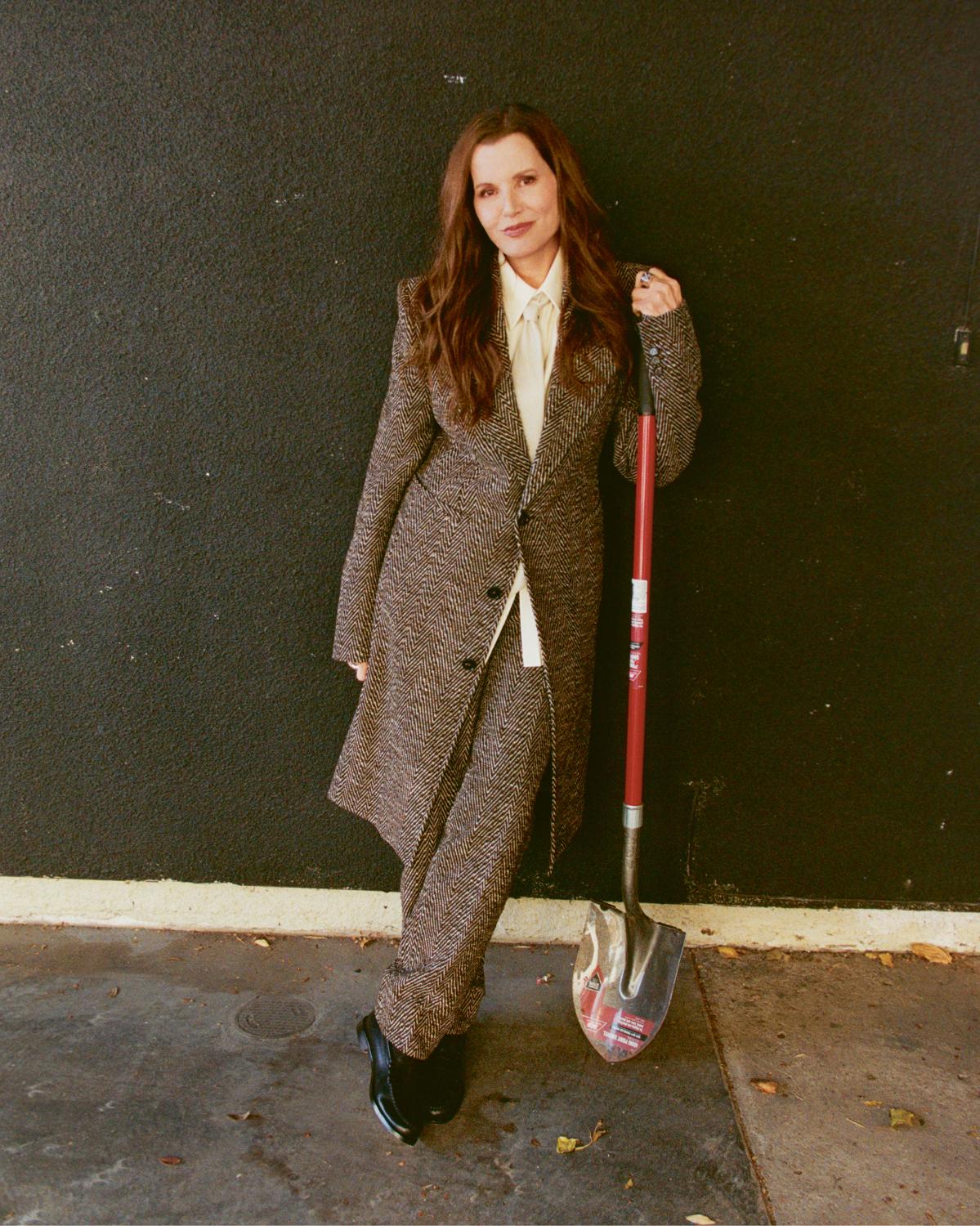
Everybody digs Geena. Here she is wearing a black, brown and cream cotton chevron coat and trousers with a pastry-coloured shiny nappa leather shirt and matching tie, all by BOTTEGA VENETA. The black merino-and-silk No. 3 Finest socks are by FALKE and the black vintage leather loafers are the stylist’s own. Geena wears her own jewellery throughout.
By the mid-1990s Geena was defying all typecasting, playing a hard-bitten TV journalist (in Hero, with Dustin Hoffman), a CIA assassin (The Long Kiss Goodnight) and a pirate captain (Cutthroat Island). Egged on by her action-film-director husband, Renny Harlin, she did her own stunts. That’s another thing you need to know about Geena Davis: she’s no wuss. She learned to shoot pistols, to sword-fight and to ride. But as she reached her 40s, critical praise and commercial reliability tailed off. Harlin’s Cutthroat Island was a financial shipwreck (unfairly — it’s a riotous film, worth a watch for Geena’s acrobatics alone). Her $8 million fee was the highest ever paid to a female actor at that time.
“I did a great majority of my own stunts,” she says, “The director happened to be my husband, and he was like ‘She can do it. Of course she can do it.’ And that somehow gave me the confidence. I was hanging on a wire 300 feet above rocks. And this crazy stuff that I did, it was terrifying, but really fun to accomplish.”
In her 2022 memoir, Dying of Politeness, Geena describes the desperate sense of loss that came with having work dry up as she reached middle age. “It was devastating,” she writes. “I wanted to do more of the job I lived for, not less.” She jokes now about “taking out a full-page ad in Variety to let people know I’m available” and gives a wry line about asking her agent to look out for the roles Liam Neeson has passed on.
Is there — to use her favourite term — a badass she would have liked to play but didn’t? “Oh, sure. I would’ve liked to be an Erin Brockovich.”
In the absence of heavyweight film parts, Geena found a new purpose, from an unlikely source. Settled in Los Angeles, by then in a relationship with the paediatric surgeon Reza Jarrahy, Geena had a daughter, now 21, followed by twin sons, now 19. “When my daughter was old enough, I said, ‘Oh, we can watch preschool shows! It’s going to be fun!’ ” What came next was a shock.
“I picked a show, and within five minutes I said, ‘How many female characters are in this? Painfully few. Incredibly few.’ ” Then she rented a kids’ movie. Same thing. Her two-year-old daughter beside her, Geena began watching an array of kids’ media. Not only were females underrepresented, she noted, they were pathetically stereotyped. “I thought, What is going on here? What are we doing?
“I immediately extrapolated it to a global view: that we are seemingly training kids that boys are more important. Boys are the ones that are funny. Boys are the main story. And girls — even in stuff for little kids — tended to be sexualised or very narrowly stereotyped. And I thought, Well, this is terrible and has incredible implications.”
She was spurred into action. “I didn’t intend to launch an institute.” She beams and sips from one of the two cups of coffee she has ordered. “But I couldn’t find one other person who’d seen what I saw.”
When she brought up the on-screen gender imbalance with Hollywood friends and colleagues, she was given the brush-off: what about Disney princesses? “But what I was talking about was that the world of a movie was empty of female characters,” she says. Crowd scenes. Groups of schoolchildren. Geena was so convinced of the skew that she privately commissioned a research study – and got the data. It took two years. But the numbers were unarguable.
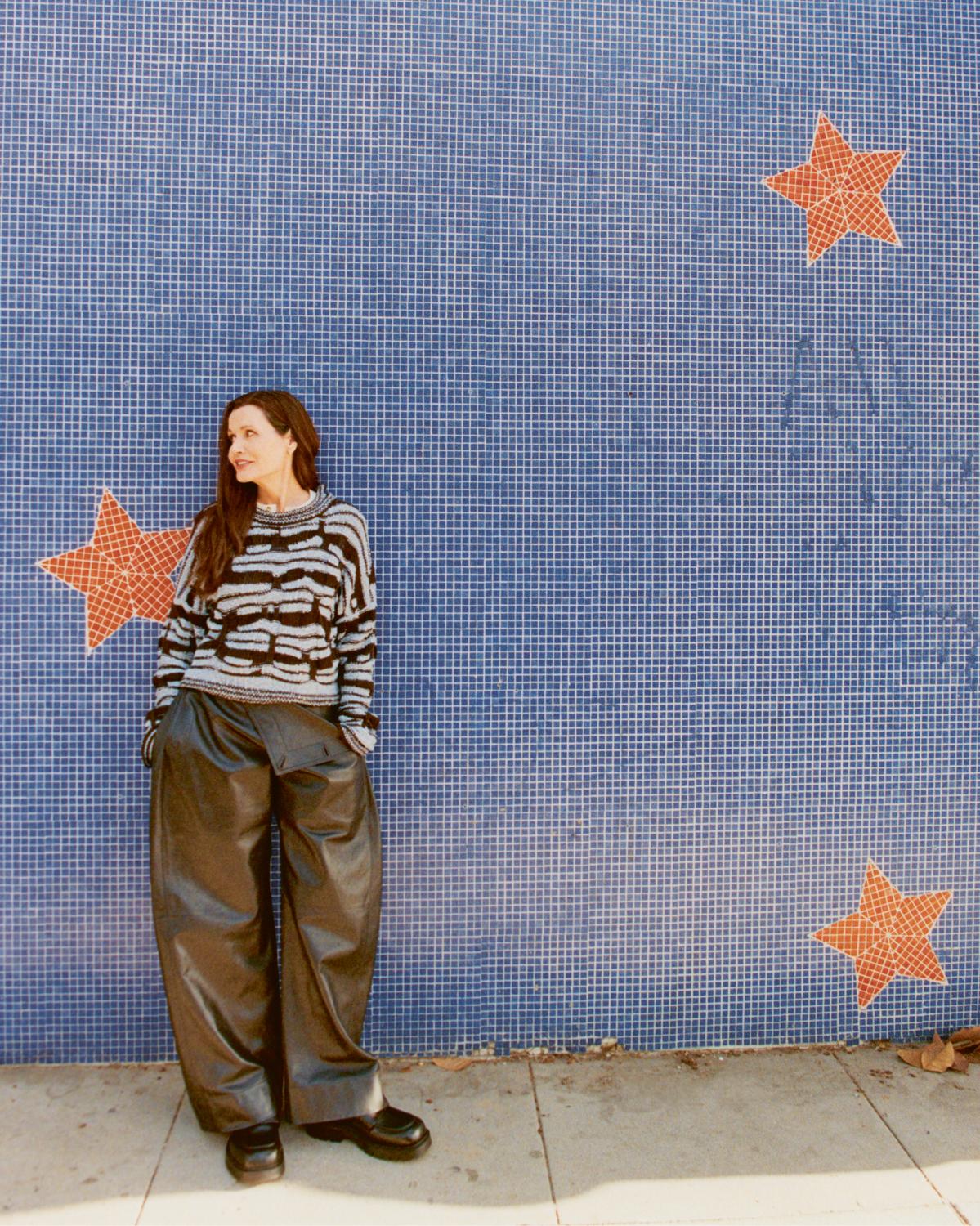
Geena is pictured in Santa Monica, California — a suitably starry location. She’s in an admiral-and-fondant cotton distorted-stripe jumper over a chalk cotton underpinning jumper, shadow nappa leather trousers and black crinkled nappa Astaire loafers, all by BOTTEGA VENETA.
Geena started visiting creators of children’s films and programming in Los Angeles. Naturally, doors opened for the Oscar-winning actor. “I just said, ‘I have this data, and I’d love to come and talk to you.’ It was no problem getting meetings. One company gathered 200 people.” Geena is adamant that the bias was and is “utterly unconscious”, and she recalls the looks of amazement when executives realised the general lack of female voices and faces in their productions.
“Data has been the absolute magic key,” she says. “They needed to have it proven to them that there was this tremendous dearth of female characters. They talked about how much they cared about [gender balance], but they were missing the point, which was that the worlds were imbalanced. Even if you had a female as the lead, where was everyone else?” One of her earliest reports in 2008 revealed that in a study of 15,000 individual speaking characters conducted with Stacy Smith, an associate professor at the USC Annenberg School for Communication and Journalism, males outnumbered females 2.71 to 1.
A self-described nonconfrontational person, Geena says her mission was to work behind the scenes directly with media entertainment corporations. “I managed to come up with something that absolutely fits my personality. I want people to like me; I want to be nice. I found a way where there’s no shaming and blaming. I’m not accusing you of anything — I’m coming here as your friend. I want us to work together collegially. And I want you to keep hiring me.” She laughs.
In 2004 she founded the Geena Davis Institute on Gender in Media. It partnered with Google in 2016 to create a tool, GD-IQ, that analyses media content for bias, and it made early relationships with, among others, Mars and Lego – behemoth companies that shape what children see and desire in childhood. “Mars ads are now gender-balanced, after a consultation with them,” Geena says proudly. Her organisation, which has a core team of 12 plus a board of directors, produces detailed reports every year for film and TV that look at variables including gender, 50+ age, body type, disability, and the representation of people of colour and LGBTQ people. It partners with a dozen PhD researchers to gather its own data and launches reports cited globally by news organisations including The New York Times, Variety and CNN. And its data still smarts: in a 2023 report on children’s TV, in new shows only 43 per cent of characters were female.
“Geena pioneered this field of research, looking at on-screen representation,” Madeline Di Nonno, the institute’s CEO, says. Back then nobody was thinking about gender and the effect that had on the real world. “Many people have been looking at the dearth of female writers and directors. No one thought about women on screen,” Di Nonno says. She describes Geena as “the kind of celebrity who is very serious and will do the work.”
For her part, Geena reels off a list of additional reports the institute will publish this year: “Portrayal of women and girls in Stem, cultural portrayals of motherhood, mental health in children’s TV, global diversity and inclusion in advertising…” The list goes on. I suggest that the institute is an unusually altruistic way of tackling sexism in Hollywood. Don’t female actors more commonly set up their own production companies, effectively hiring themselves? Geena won an honorary Oscar, the Jean Hersholt Humanitarian Award, in 2019 for her research, but has all this toil actually helped her acting career?
“Whenever someone says, ‘Yes, we should have more female characters,’ I joke that it’s all a 20-year plan to get myself more work – which is not working!” she quips.
“I would’ve liked to be an Erin Brockovich.”
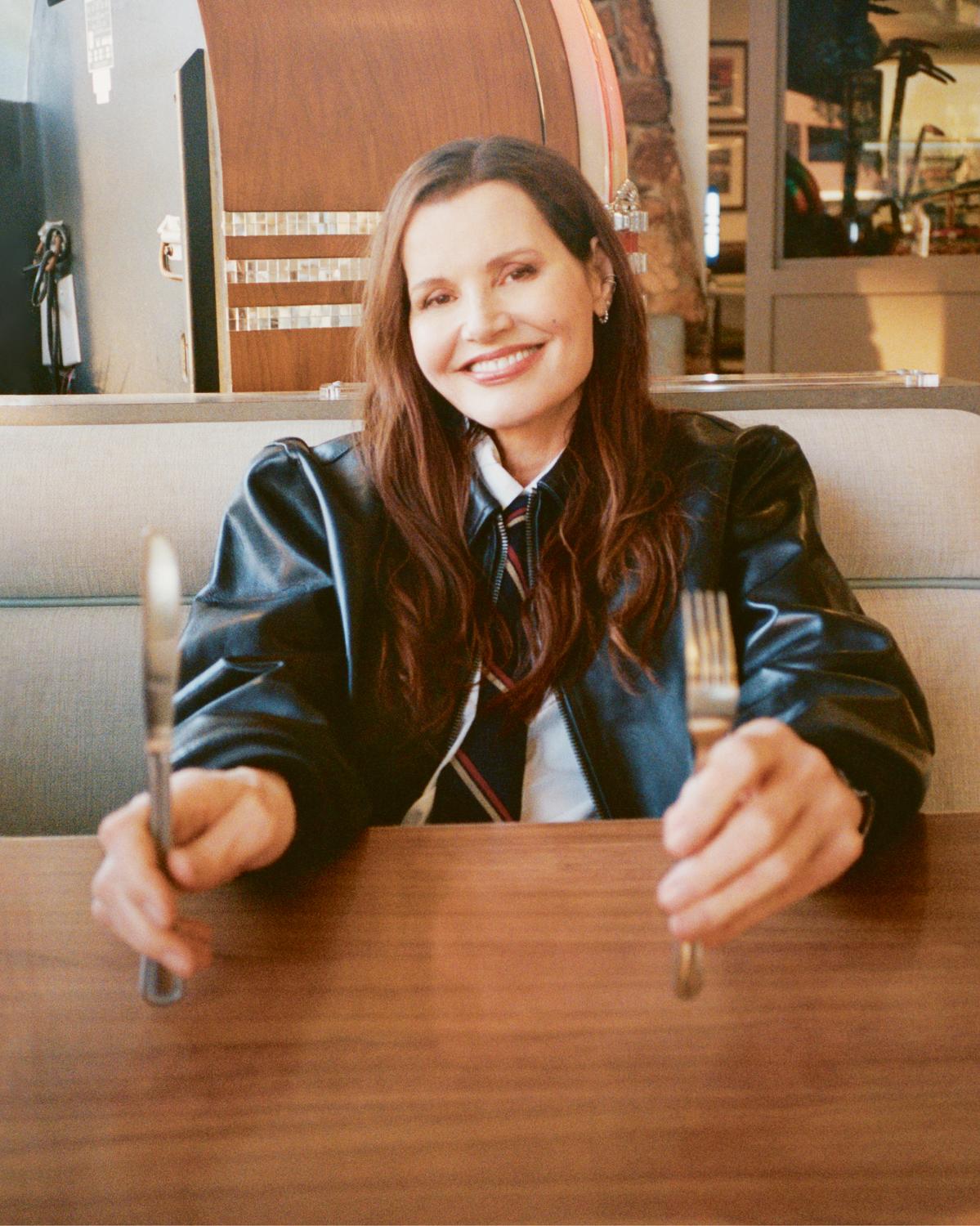
To eat in? Geena wears a black leather A2 flight jacket by J.CREW over a white cotton Adrian shirt by RALPH LAUREN. The navy, red and gold striped silk Classico tie is also by J.CREW and the indigo cotton Fairfax jeans – seen only in the next image — are by A.P.C.
It was Tootsie in 1982, that signalled the arrival of Geena Davis. Dressed only in her underwear, a 26-year-old Geena makes Dustin Hoffman’s iconic drag character, Dorothy, twitch with awkwardness in the dressing room of the trashy hospital TV soap in which they are both actors. It was only a minor role in Sydney Pollack’s classic, but it enabled Geena to switch from modelling to acting.
She had grown up in Wareham, Massachusetts, in a family that knew nothing of Hollywood, yet she announced her plan to be an actor at the age of three. “How did I even know it was a job? I have no idea. But that was all I wanted to do.” Her parents, Bill and Lucille, were practical, unworldly folk. She has said that they would have been Amish “had they heard of being Amish”. Her mother chose the unusual spelling “Geena” because the conventional name looked too much like “vagina”. Geena and her brother, Dan, two years her senior, were raised to be extremely polite.
The Davises accepted Geena’s plan to study acting at Boston University without question. “I think they knew so little about it, and it would be incredibly rare and freaky if I was able to have a successful career,” she tells me.In the following years, Bill and Lucille would dutifully attend screenings of their daughter’s films and even appear as townsfolk extras in Tim Burton’s 1988 comedy-horror Beetlejuice (Geena played a ghostly newlywed but isn’t reprising her role in this year’s sequel). However, they balked at one key moment of what she terms “my bug phase”. David Cronenberg’s 1986 film, The Fly, starred Jeff Goldblum as a mad scientist who accidentally fuses his DNA with a bluebottle; Geena is a scientific journalist who ends up in his bed (they were a couple by the end of filming). “Jeff and I adored the operatic love story, and it was super fun, if a little goopy. There was always some slime going on.” It is still gruesome, 38 years later. Her parents did not approve.
“My brother called, and I knew he’d watched it with them,” Geena remembers. “He said, ‘We loved it.’ ”
But her parents were reluctant to talk to her. Eventually her mother got on the phone.
“I said, ‘Mom, what the hell? What’s wrong? What was it? The monkey turning inside out?’ ”
Geena whispers in a feeble voice: “ ‘The sex…’ ”
It didn’t help that she and Jeff were in a relationship at that point? “We were a couple. That didn’t make any difference.” The two married the following year. Geena has said that she regrets the hasty end of their relationship three years later. (Guarded on the subject of her personal life, she has been married three times: first in a youthful commitment to a Brooklyn waiter, Richard Emmolo; then to Goldblum, in a Las Vegas wedding; and later to the director Renny Harlin. She recently finalised a separation from Reza Jarrahy.)
It was through Goldblum that she became friends with the director Lawrence Kasdan, eventually winning the role of Muriel Pritchett in his 1988 film, The Accidental Tourist. Muriel is an eccentric dog trainer from the wrong side of Baltimore who takes William Hurt’s privileged Wasp as her lover.
“I’d read the book while I was making The Fly; I’m a fan of Anne Tyler’s work. I realised they were going to make the movie and that I hated whoever was going to get to play that character, because I wanted to play her,” Geena says. “Then it turned out Lawrence Kasdan was going to direct it, and Jeff and I socialised with him and his wife all the time. And I didn’t want to say anything to make it seem like I was getting our friendship mixed up with business.
“I finally thought, I can’t not mention that I want to play this part. I can’t let it go by. He said, ‘Oh really? I wouldn’t have thought of you, with your patrician background.’ ” Geena laughs. “He had assumed that because I’m from near Cape Cod I hung out with the Kennedys or something. I said, ‘No. Nothing like that.’ ”
Geena got the part and prepared feverishly. “I wrote lists of all the verbs that Tyler used to describe Muriel’s actions — ‘She clicked into the room’ and all that. All the adjectives and descriptors.” She won best supporting actress at the Oscars the following March, seeing off Sigourney Weaver, Frances McDormand, Joan Cusack and Michelle Pfeiffer.
“I thought the movie might get nominated, and Larry was known as a very talented director, and Bill Hurt, of course, but I didn’t think it would trickle down to me,” she says modestly. “I was very happy they looked there.”
With the Academy Award came juicier roles, but Geena’s self-deprecating manner didn’t alter until she met Susan Sarandon, an actor 10 years her senior. The way Geena tells it, hers is very much a life of two parts: one before becoming friends with Sarandon and another after.
“The minute I met her, my jaw fell,” Geena says now. They met when they were cast in Thelma & Louise, and the women are still close friends. “Everything I said or did had been prefaced by ‘I don’t know what you think,’ or ‘This is probably a stupid idea.’ And to see, to experience, a woman who doesn’t preface everything with apologies and actually just says what she thinks was revolutionary.”
Did Geena ask her for advice?
“Constantly, constantly. Susan was a very mentoring experience. We loved each other equally, but it was incredibly eye-opening [on set]. It wasn’t that she was confrontational or demanding — I mean, everybody loved her. And it wasn’t like ‘We love Geena a little more because she’s so wimpy.’ It was accepted as completely normal to move through the world as she did, saying what you think.”
In her memoir, Geena recalls Ridley Scott suggesting that she remove her top for one of the driving scenes in Thelma & Louise. Sarandon, when she hears of this idea, calmly walks over to Scott and announces that, no, Geena will not be taking her top off. “It was a kind of reprogramming for me,” Geena writes.
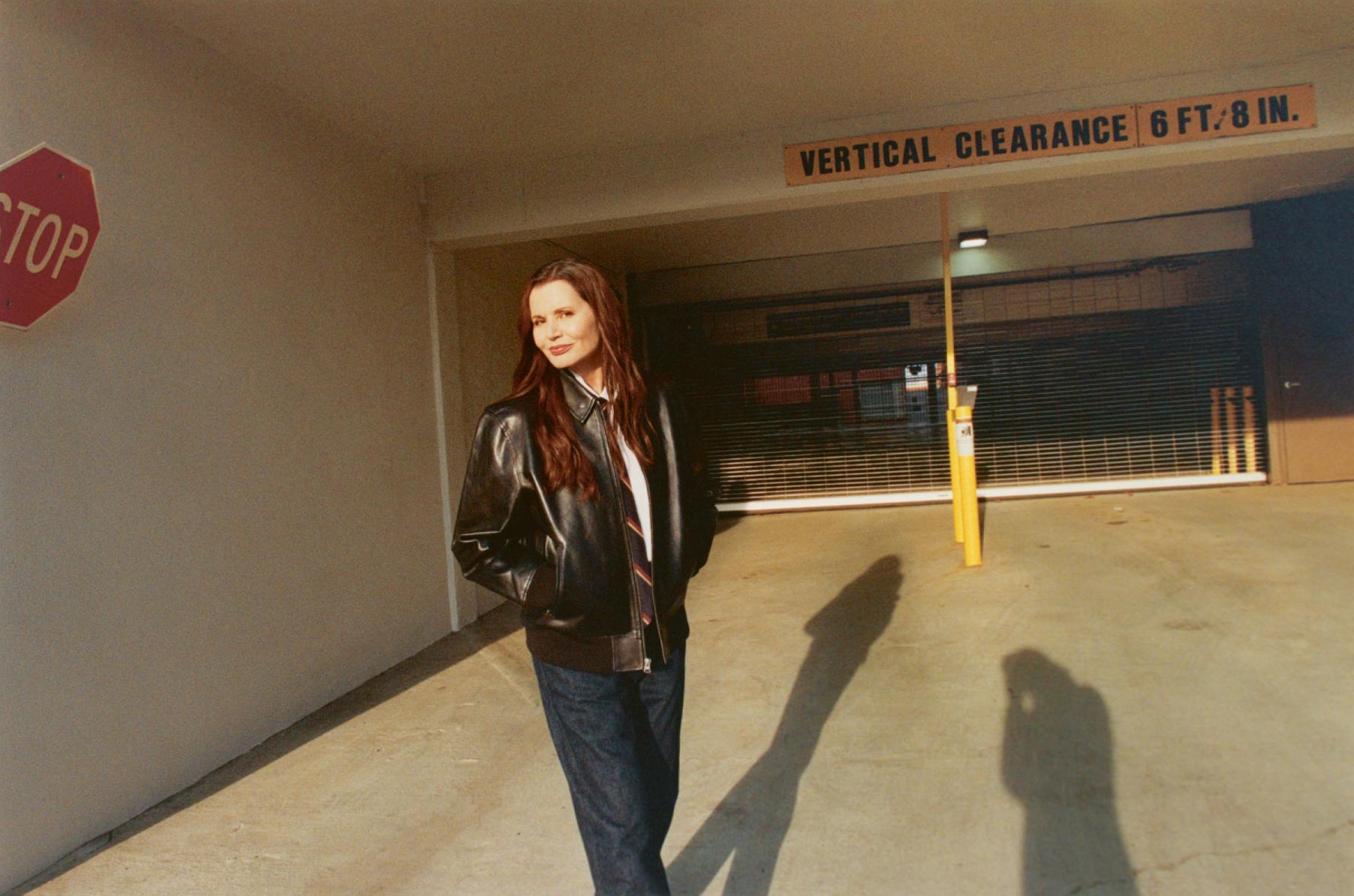
“The minute I met Susan Sarandon, my jaw fell.”
There is an intensity to Geena that she brings to every new project. One part of that is her unarguable physical beauty and presence. Another could be related to a diagnosis she received in her early 40s. “I started with a new therapist around the time when my marriage to Renny Harlin ended. After a couple of sessions, he asked, ‘Has anyone said that maybe you have ADD?’ ”
Geena says she doesn’t have “the H”. She seems quite busy, I say.
“I know, but I’m really a big slug. My favourite position is lying on the sofa,” she replies.
In any case, the ADD diagnosis made sense to her. “I was tested, and I was off the charts. It explained everything. My whole childhood, I was very smart. I cruised through everything. But when it got to middle school, when you had to write a report that took more than one day, I was completely screwed. I carried this terrible shame that I couldn’t finish things. It was such a big secret — it was frustrating and embarrassing that I was somebody who started a million things and couldn’t finish.”
Making a feature film, with its producer- and budget-imposed structure, was the perfect corrective to Geena’s ADD. “Life is adrift unless a gun is to your head. That was the expression. And what’s more gun-to-your-head than having to shoot this scene, right now, with hundreds of people relying on you?”
She needs pressure, and she plays women under pressure extremely well. Her role as the first female president of the United States in ABC’s 2005 drama Commander in Chief was tragically cut short after one season. “The heartbreak of my life,” she says with a sigh. “I should have had a longer administration.” The viewing figures were stout, and Geena won a Golden Globe for her self-possessed polit-ician. And yet “It ended up getting cancelled.” A shame, she says, because being president “totally went to my head.”
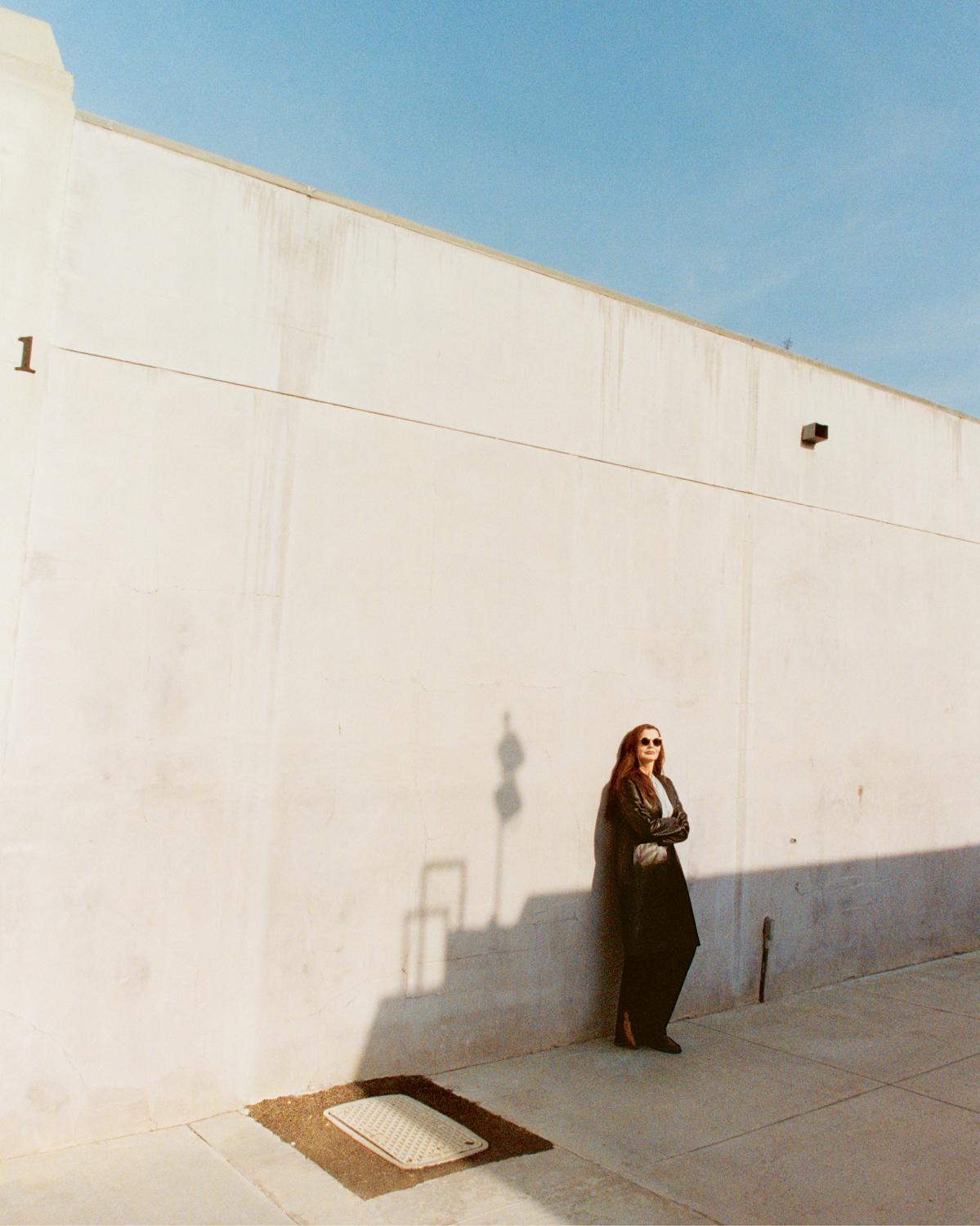
Cool as, in a black soft matte nappa leather Babil coat, powder-blue organic cotton-jersey Steven top, and black vintage corduroy Chan trousers, all by THE ROW. The sunglasses, belt and loafers are the stylist’s own.
She’s a badass in her spare time too. Years ago, she tells me, “I wanted to find a sport and find out if I could be really good at it. I was learning all these different skills and sports for movies, and I was kind of good at all of them.” During production in 1996 of The Long Kiss Goodnight — which probably has the highest body count of any of her films — she had intensive training with guns. “The coach had said, ‘You have a lot of untapped talent. I think you could compete in pistol shooting if you wanted to take it up seriously.’”
Did that push her buttons?
“Yeah!” she says, and takes a sip of her now-cooled black coffee. “But I thought, How do I pick up a pistol? I can’t practise it in my yard.” Then, during the coverage of the Atlanta Olympics that same year, she saw a clip of Justin Huish, who went on to win two gold medals in archery, training at home. “I’m like, I’ll try that. It’s a kind of weapon.” Geena sought advice from Huish, who recommended a coach. And that was it.
“Within a couple of months, he said, ‘You’ve got to start competing.’ I’m competing? You’re kidding.” By 1999 she was among the top archers in the US, even trialling for the national Olympic team (she was a semi-finalist and placed 26th; the top 16 made the team).
Besides getting the equipment exactly right and training to pull a bow to a certain draw weight, the coach told her, the main challenge of archery is to recreate the same shot every time. “It’s all a battle with yourself. The slightest difference in how you are thinking will change your shot. It’s fascinating.” Geena began to train obsessively. Any break from the schedule would result in a dip in form. “Just by stopping for a few days you lose some of that strength.” When Hugo Boss invited her to attend its fashion show in Milan, her coach said she could only travel if she carried on training. She took her bow with her, entered an archery tournament in Tuscany — and won. “You can’t just dabble,” she says, which is why she’s paused archery for now.
In the absence of sport, those steady hands have been busy: a hobby of elaborate pumpkin carving has, she relates, given way to a fascination with egg carving. Geena is a big crafter. “I got Martha Stewart’s magazine one Easter, and on the cover it had an egg that was open with a little hinge on it. You use a little Dremel tool with different blades on to cut the eggs. I have 12 different sizes of egg, from ostrich down to lovebird, and the overall plan is to make them nesting eggs. I’ve carved animals into the ostrich.
“I do have an incredibly steady hand. I could paint with an eyelash. Yes, I could be a microsurgeon or something,” she jokes. “I love tiny stuff.” (She also collects vintage gold charms — a baseball, a tiny gun, a pirate ship — sourced from eBay and Etsy, and is stringing a bracelet with these miniature trinkets to represent each of her movies.)
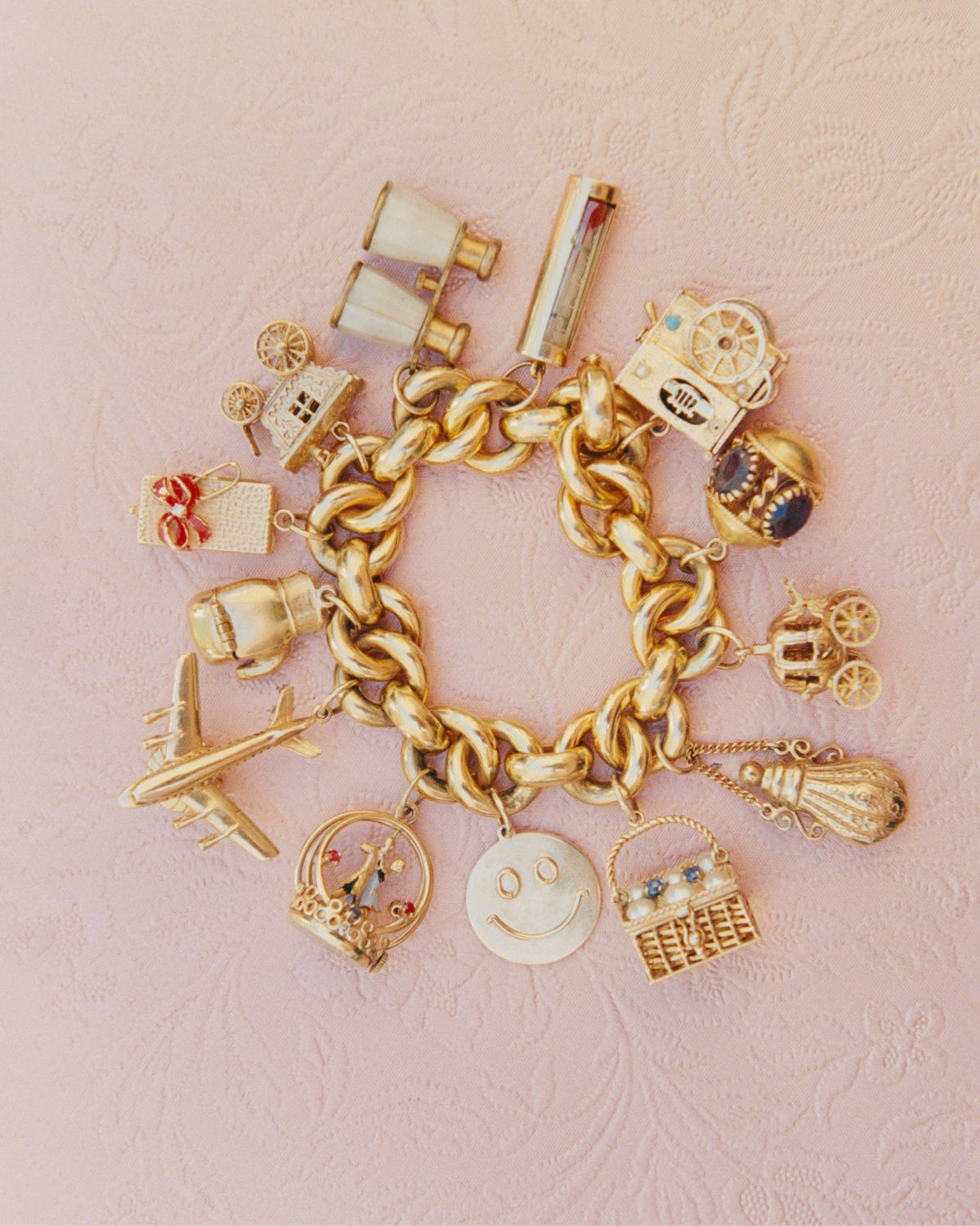
The bracelet is Geena’s own; the vintage charms were sourced from eBay and Etsy and represent each of her movies. The bracelet itself is also a reference to The Long Kiss Goodnight, her 15th film, in which she played a government assassin, Samantha Caine, who, in one scene, gives a charm bracelet to her daughter, Caitlin.
Geena’s next role is in a suitably dark-sounding #MeToo thriller, Blink Twice, directed by Zoë Kravitz and due for release in August, about a tech billionaire (Channing Tatum) who takes a cocktail waitress away to his private island. Geena plays Tatum’s assistant. “I get to be funny in this role,” she says. Kravitz describes Geena as “A Mensa and an actual genius, unapologetically powerful not only as an actor but as a human.” Was Kravitz swayed by Geena’s two decades of research into female on-screen representation? “Absolutely,” she says. “I’ve always admired how outspoken she’s been about female experience and how things need to change.”
This June sees the 10th anniversary of the Bentonville Film Festival, which Geena launched — the Arkansas town didn’t even have a cinema at the time — to promote “the work of women and diverse voices in film and television”, specifically behind the camera. “Everybody has known for decades the abysmal number of female directors,” she says. A popular festival event has been Geena and Friends, in which she and other female actors reimagine male-dominated movie scenes. It suits Geena’s feminism perfectly: good-natured, hilarious, subversive. Last year’s update of The Godfather, in which Geena played “Frieda” Corleone (in tribute to John Cazale’s sleazy Fredo), is worth a watch on YouTube.
“I always remind people that one of the easiest ways to create female characters is just change the first name,” she says emphatically. We rise from awkwardly low seats for a goodbye embrace, leaving behind three half-drunk cups of cold coffee. Geena is still warm to her theme. She can make flipping the script sound as simple as driving a car off a precipice. “To make female roles, that’s all you need to do.”
Susie RushtonSusie Rushton is a writer and editor living in London, currently serving as deputy editor of Telegraph Luxury. Previously, she was features editor at UK Vogue, deputy editor of Porter and editor of The Independent Magazine. Susie is also a nationally-ranked fencer; her weapon of choice is the foil. read more Portraits by
Chris RhodesThe British-born photographer Chris Rhodes works intuitively with environments and subjects, celebrating life’s fleeting moments and finding allure in the ordinary. His clients include Bottega Veneta, Burberry, Gucci, Jil Sander and Miu Miu; he is represented by Webber Represents.read more Styling by
Gabrielle MarcecaGabrielle Marceca is a fashion stylist and consultant based in New York City. A native to the Big Apple, Gabrielle studied at the Fashion Institute of Technology and cut her teeth assisting stylists Kate Young and Vanessa Traina. Since launching her own career in the industry, Gabrielle has shot campaigns…read more
Hair: Jonathan Colombini. Make-up: Holly Silius. Set design: Kelly Infield. Tailor: Susie Kourinian. Production: Connect the Dots.
This profile was originally published in The Gentlewoman nº 29, Spring and Summer 2024.